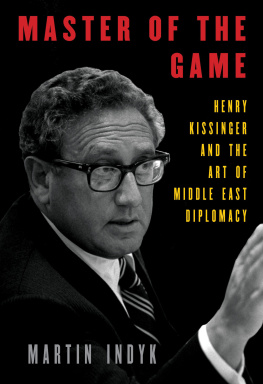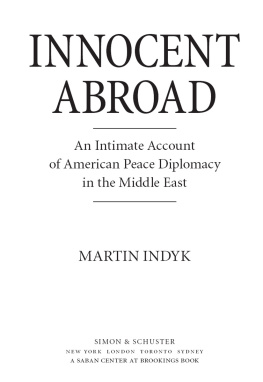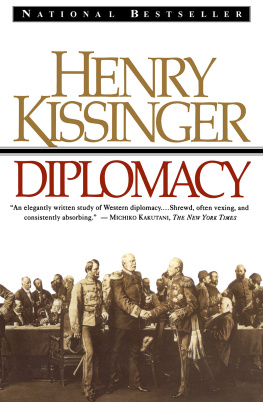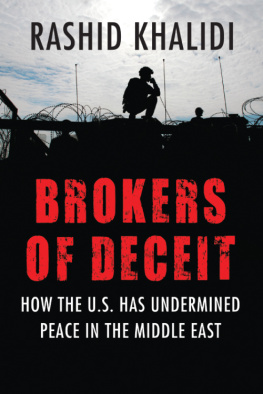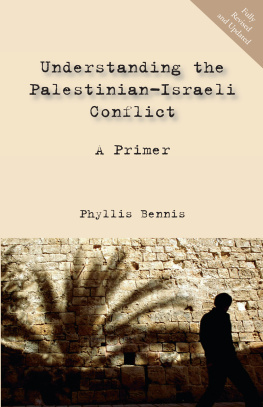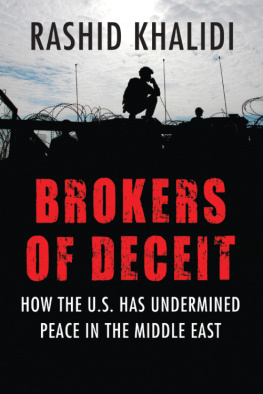Acknowledgments
The idea for this book was conceived in long conversations with Jonathan Segal, my editor at Knopf. He was intrigued by what diplomats did behind closed doors in their efforts to negotiate peace in the Middle East. Out of my attempt to explain it to him came the idea of writing a book about Henry Kissingers Middle East diplomacy, illuminated by my own experiences negotiating Middle East peace twenty years later. Throughout this eight-year journey, with its long hiatuses, Jonathan has patiently nurtured and painstakingly edited the manuscript, and taught me to write along the way.
This book would not have been possible without the extensive cooperation of its subject, Henry Kissinger. He granted me access to his papers, but far more important, through many hours of conversation, he gave me access to his thinking. In his nineties, he remains a formidable intellect. I expect he will feel that the generosity and friendship he has shown me have not been reciprocated by some of my criticisms in these pages. I hope he will understand that, taken in full, this book reflects my deep respect for him and my appreciation of his statesmanship.
I began writing this book at the Brookings Institution in Washington and completed it at the Council on Foreign Relations in New York. I am particularly indebted to my friends at both these institutions for the unstinting support they have provided. In particular, Richard Haass, the president of CFR, and Strobe Talbott, the president of Brookings at the time, inspired and encouraged me throughout this long journey.
I am deeply grateful to the many research and administrative associates who were indispensable to the completion of this project. Nicki Alam and Charlotte Baldwin at Brookings and Amy Baker and Shira Schwartz at CFR supported me tirelessly. Nadav Greenberg and Yael Mizrahi-Arnaud did the lions share of the work of tracking down documents in the archives and libraries in both the United States and Israel, including translating them from Hebrew. I will cherish those moments of delight when they would burst into my office to share with me their latest discovery. Roni Kipnis complemented their labors in the Israeli archives. Basia Rosenbaum checked all the references, tracked down the photos, and took care of the myriad details involved in shepherding the manuscript to publication, all with amazing ingenuity and persistence. This book is as much a reflection of their efforts as my own.
I also depended on a number of interns to supplement the work of these research associates. In particular, Matthew Eady, Kitaneh Fitzpatrick, Andrea Kemmerle, Connor McCune, Michael Reeves, and Daniel Waqar contributed their energy and talent.
A host of librarians helped in locating documents and photographs. In particular, I would like to express my appreciation to Louise Fischer and Yaacov Lozowick at the Israel State Archives; Ernest Emrich and Margaret McAleer at the Library of Congress; Joshua Cochran, who handles the Kissinger Papers at Yale University Library; Melissa Heddon at the Richard Nixon Presidential Library; and Elizabeth Druga at the Gerald R. Ford Presidential Library.
William Burr and the National Security Archive at George Washington University deserve special praise for the remarkable job they have done in securing the declassification of many of the documents used in this study. Similarly, Erich Stein and the researchers at the State Departments Office of the Historian made an invaluable contribution to this study through their expert curation of the Foreign Relations of the United States documentary compendiums.
The wonderful professionals at Knopf did an excellent job shepherding the manuscript to publication. I am deeply grateful to Chip Kidd, Cassandra Pappas, Nicole Pedersen, Sarah Perrin, Erin Sellers, Nicholas Latimer, and mapmaker David Lindroth.
Special thanks to Vivian Dinitz, who shared the unpublished memoirs of her husband, Ambassador Simcha Dinitz, whose role in this drama has gone unrecognized for too long.
Liaquat Ahamed, Nahum Barnea, Ivor Indyk, James Lindsay, Shannon ONeill, Itamar Rabinovich, Robert Satloff, Asher Susser, and Ehud Yaari, as well as two anonymous peer reviewers, read the manuscript, providing me with sage advice and correcting the record where they could. Winston Lord, William Quandt, Harold Saunders, and Brent Scowcroft, all members of Kissingers team, provided crucial insights. Nabil Fahmy and Ahmed Aboul Gheit shared their invaluable understanding of Egyptian policymaking at the time. Amos Eran, Efraim Halevy, Dalia Rabin, and Moshe Raviv provided fascinating perspectives on the Israeli side. The other people I interviewed for this book are too numerous to name but I am deeply grateful to all of them. The remaining shortcomings are my responsibility.
Writing a book requires the sustenance and encouragement of friends and family. Charles Bronfman, Ronnie Cohen, Hirsh Goodman, Jacob Indyk, Sarah Indyk, Ben Jacobs, Frank Lowy, Jeffrey Skoll, Harry Solomon, and most important, Haim Saban, have been generous and genuine in their friendship and support.
Special thanks to the Friedman Family Foundation Strategic Innovation Fund, the Lowy Institute for International Policy, and the Skoll Foundation for their support for this project.
My wife, Gahl Hodges Burt, has been my constant companion, inspiration, and gentle critic. Reading the manuscript together on balmy days in Central Park is my fondest memory of the miserable pandemic. We began this journey with Henry Kissinger separately, forty-seven years ago. I am so grateful that we are ending it together.
I have dedicated this book to my grandchildren in the hope that they too, with the guidance of their wonderful parents, will pursue peace in their lifetimes, following the teaching of the Torah sages that it is not up to us to finish the job, but neither can we desist from it.
Appendix A
Egyptian-Israeli Agreement on Disengagement of Forces in Pursuance of the Geneva Peace Conference
January 18, 1974
A. Egypt and Israel will scrupulously observe the cease-fire on land, sea, and air called for by the UN Security Council and will refrain from the time of the signing of this document from all military or para-military actions against each other.
B. The military forces of Egypt and Israel will be separated in accordance with the following principles:
All Egyptian forces on the east side of the Canal will be deployed west of the line designated as Line A on the attached map. All Israeli forces, including those west of the Suez Canal and the Bitter Lakes, will be deployed east of the line designated as Line B on the attached map.
The area between the Egyptian and Israeli lines will be a zone of disengagement in which the United Nations Emergency Force (UNEF) will be stationed. The UNEF will continue to consist of units from countries that are not permanent members of the Security Council.
The area between the Egyptian line and the Suez Canal will be limited in armament and forces.
The area between the Israeli line (Line B on the attached map) and the line designated as Line C on the attached map, which runs along the western base of the mountains where the Gidi and Mitla Passes are located, will be limited in armament and forces.
The limitations referred to in paragraphs 3 and 4 will be inspected by UNEF. Existing procedures of the UNEF, including the attaching of Egyptian and Israeli liaison officers to UNEF, will be continued.
Air forces of the two sides will be permitted to operate up to their respective lines without interference from the other side.
C. The detailed implementation of the disengagement of forces will be worked out by military representatives of Egypt and Israel, who will agree on the stages of this process. These representatives will meet no later than 48 hours after the signature of this agreement at Kilometer 101 under the aegis of the United Nations for this purpose. They will complete this task within five days. Disengagement will begin within 48 hours after the completion of the work of the military representatives and in no event later than seven days after the signature of this agreement. The process of disengagement will be completed not later than 40 days after it begins.

